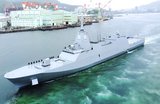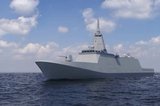Royal Navy follows US Navy lead, invests in VR training to mitigate watchkeeping skill fade
The view from the bridge in Kilo’s VR trainer. (Image: Kilo Solutions)
Kilo Solutions, a UK-based VR maritime training provider, has won a contract with the Royal Navy (RN) to supply 24 units of its “virtual advancement system for competent operations” (VASCO), to help RN officers with their bridge watchkeeping, mission rehearsal, and skill fade prevention.
The sale of “VASCO-in-a-box” (VIAB) units to the RN adds a commercial off-the-shelf VR into the make-up of ongoing training for the UK’s naval personnel. The set-up includes four Meta Quest headsets, a dedicated router delivering a secure, standalone LAN for the training, and a preconfigured laptop containing all the VASCO training scenarios.
Users will also, as with most virtual training devices, have the ability to define and run their own missions, to ensure they get the most practical use out of the VIAB.
Related Articles
Babcock to partner with companies to develop improved VR training system
Fincantieri company launches VR and AR simulator for ROVs
The sale to the RN is Kilo’s second major order in the world of naval defence.
The first saw it work with the US Navy (USN) to deliver an adaptation of VASCO into the navy’s VIBRaNT (Virtual Bridge and Navigational Trainer) VR training system.
Andy Parkin, managing director at Kilo Solutions, said the RN contract was significant not just for the company but for the role of VR naval training as a whole: “The ability to develop and apply knowledge within a fully immersive and interactive training environment is game-changing,” he explained.
“Mission rehearsal, competency evaluation, promotion assessment alongside skill development, are now just some of the use cases that are advancing operational capability by using VR training like VIAB. VR training lets command teams maintain bridge watchkeeping standards at individual and team level like never before,” Parkin added.
VR and AR operational training became more accepted in navies across the course of 2024, with big players, including Fincantieri and Babcock exploring the potential of VR technology in a training environment.
More from Naval Warfare
-
![Future Canadian Continental Defence Corvette will provide “Halifax-equivalent capabilities”]()
Future Canadian Continental Defence Corvette will provide “Halifax-equivalent capabilities”
Although the CDC project is still in its early stages, the Canadian Department of National Defence already has some requirements for the future platforms.
-
![US Navy to acquire micro-uncrewed underwater vehicles for ISR and coastal data collection]()
US Navy to acquire micro-uncrewed underwater vehicles for ISR and coastal data collection
The Naval Supply Systems Command is seeking authorised resellers of JaiaBot uncrewed underwater vehicles and multivehicle pods. The platforms will support undergraduate education at the US Naval Academy.
-
![NATO tests use of “undetectable, jam-proof” laser communication in maritime scenarios]()
NATO tests use of “undetectable, jam-proof” laser communication in maritime scenarios
As part of its effort to better prepare its capabilities for operations in contested and congested scenarios, NATO evaluated a Lithuanian ship-to-ship terminal designed to not be susceptible to enemy interference.
-
![Future of the Canadian Patrol Submarine Project is still unclear]()
Future of the Canadian Patrol Submarine Project is still unclear
The Canadian government remains tight-lipped on the timeline and funding required for the next steps of its Canadian Submarine Patrol Project, which should offer improved capabilities for the country’s navy.
-
![Mitsubishi eyes future with Australia’s Mogami selection]()
Mitsubishi eyes future with Australia’s Mogami selection
With Australia’s selection of the Mogami-class for Project Sea 3000, Mitsubishi is investigating local production in the next decade as potential export opportunities emerge.
























